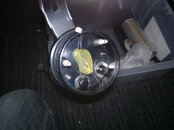Hello from Finland fellow divers  I recently bought a second hand dive torch (Suunto Finnlight F100) which I'm now modding to be a led light. The problem I have since I have to scratch the old electronics (due to different voltages and other stuff) is that the original on&off swithes are made with magnetic push buttons (separate on and off buttons which bounce right back up after pushing down)
I recently bought a second hand dive torch (Suunto Finnlight F100) which I'm now modding to be a led light. The problem I have since I have to scratch the old electronics (due to different voltages and other stuff) is that the original on&off swithes are made with magnetic push buttons (separate on and off buttons which bounce right back up after pushing down)
How could I use these buttons or one of them to turn the light on and off...I've once made a FET & Reed magnetic switch but it doesn't "hold" the state (the magnet has to be there all the time) like the one I'm now in need of. I need a magnetic switch system that turns the light on when pushed down (and then the magnetic button bounces right up) and turns the light off when pushed down again.
I'd really appreciate if someone knows how to implement this kind of electronics to my lamp. thanks in advance for resolutions.
How could I use these buttons or one of them to turn the light on and off...I've once made a FET & Reed magnetic switch but it doesn't "hold" the state (the magnet has to be there all the time) like the one I'm now in need of. I need a magnetic switch system that turns the light on when pushed down (and then the magnetic button bounces right up) and turns the light off when pushed down again.
I'd really appreciate if someone knows how to implement this kind of electronics to my lamp. thanks in advance for resolutions.







